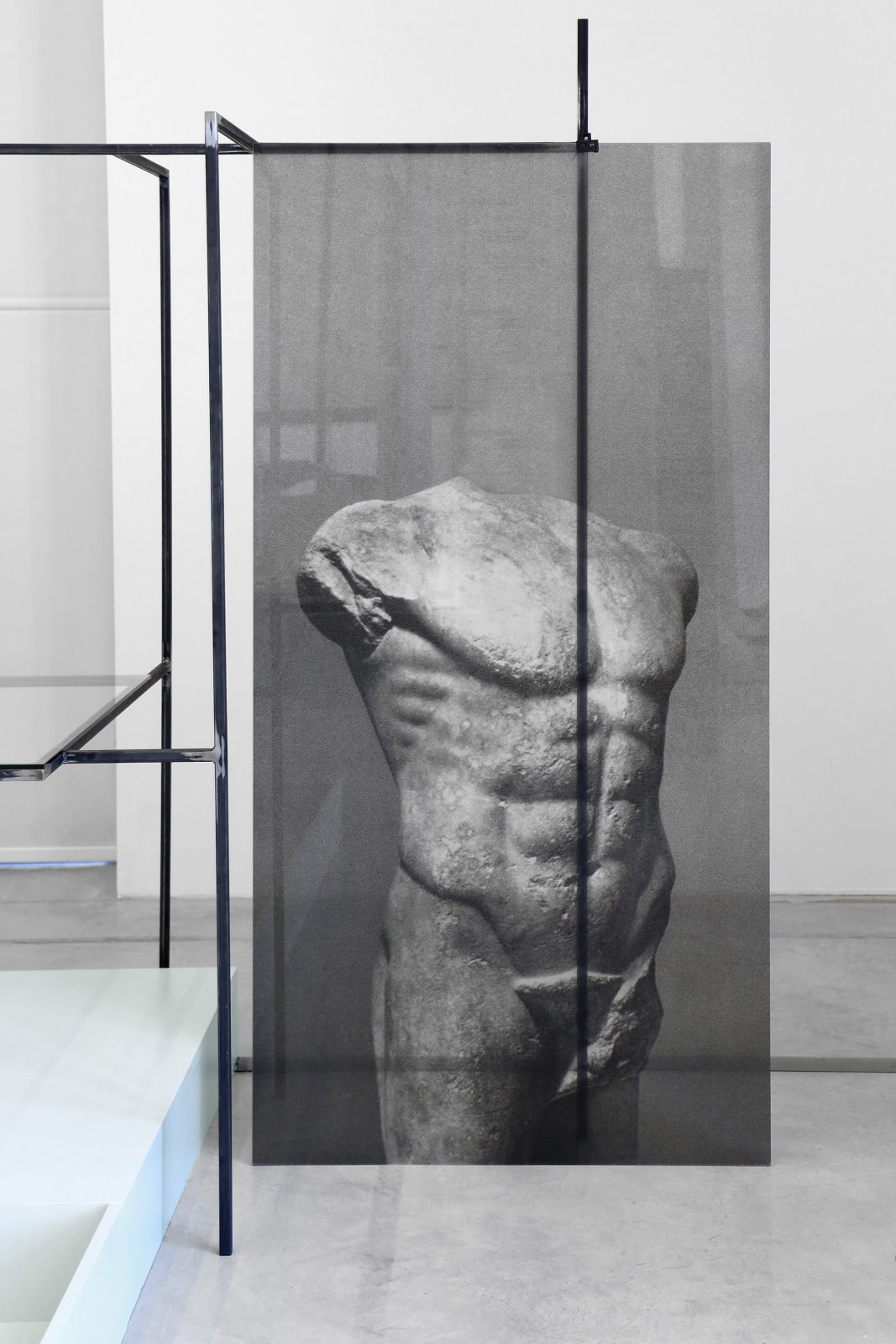Nicolás Lamas
Cabinet, 2016
Print, plexiglas and marble
190.5 x 95.5 cm
75 x 37 5/8 inches
75 x 37 5/8 inches
Copyright The Artist
Photo: Studio Nicolás Lamas
Weitere Abbildungen
„Cabinet“ (2016) spiegelt Lamas Interesse an der Fragmentierung und Rekontextualisierung von Wissen. Auf den ersten Blick erinnert die Arbeit an museale Displays und archäologische Vitrinen: eine reduzierte Struktur aus IKEA-Komponenten...
„Cabinet“ (2016) spiegelt Lamas Interesse an der Fragmentierung und Rekontextualisierung von Wissen. Auf den ersten Blick erinnert die Arbeit an museale Displays und archäologische Vitrinen: eine reduzierte Struktur aus IKEA-Komponenten dient als Träger für eine grüne Marmorplatte und einen semitransparenten Print eines antiken Männertorso auf Plexiglas. Eine körperlose Präsenz zwischen Ideal und Verlust, durchscheinend, überlagert, entrückt. In seiner Materialität wirkt der Druck fast wie ein digitales Echo vergangener Körperlichkeit. Eine grüne Marmorplatte, durchzogen von hellen Adern, verweist zugleich auf geologische Zeit und kulturelle Zuschreibung: Stein als Träger von Geschichte, aber auch als ästhetische Oberfläche und Baumaterial. Lamas nutzt Alltagsgegenstände – wie das vertraute IKEA-Möbel –, um die scheinbar festen Grenzen zwischen Funktion, Bedeutung und Erinnerung zu unterwandern. Die industrielle Standardstruktur, entleert von ihrem ursprünglichen Zweck, wird zum Träger eines spekulativen Displays. In diesem Spannungsfeld von Material und Immaterialität, von Massenproduktion und einzigartigem Artefakt, verweist „Cabinet“ auf die Konstitution von Wissen, als etwas, das sich aus Sedimenten, Leerstellen und temporären Ordnungen zusammensetzt und nicht als lineare Erzählung, sondern als dynamisches Feld von Relationen und Reibungen funktioniert.
“Cabinet” (2016) reflects Lama's interest in the fragmentation and recontextualization of knowledge. The work is reminiscent of museum displays and archaeological showcases at first glance: a reduced structure made of IKEA components serves as a support for a green marble slab and a semi-transparent print of an antique male torso on Plexiglas. A disembodied presence between ideal and loss, translucent, superimposed, enraptured. In its materiality, the print almost seems like a digital echo of past corporeality. A green marble slab, veined with light colors, refers simultaneously to geological time and cultural attribution: stone as a carrier of history, but also as an aesthetic surface and building material. Lamas uses everyday objects - such as the familiar IKEA furniture - to subvert the seemingly fixed boundaries between function, meaning and memory. The standard industrial structure, emptied of its original purpose, becomes the carrier of a speculative display. In this field of tension between material and immateriality, between mass production and unique artifact, “Cabinet” refers to the constitution of knowledge as something that is composed of sediments, empty spaces and temporary orders and functions not as a linear narrative but as a dynamic field of relations and frictions.
“Cabinet” (2016) reflects Lama's interest in the fragmentation and recontextualization of knowledge. The work is reminiscent of museum displays and archaeological showcases at first glance: a reduced structure made of IKEA components serves as a support for a green marble slab and a semi-transparent print of an antique male torso on Plexiglas. A disembodied presence between ideal and loss, translucent, superimposed, enraptured. In its materiality, the print almost seems like a digital echo of past corporeality. A green marble slab, veined with light colors, refers simultaneously to geological time and cultural attribution: stone as a carrier of history, but also as an aesthetic surface and building material. Lamas uses everyday objects - such as the familiar IKEA furniture - to subvert the seemingly fixed boundaries between function, meaning and memory. The standard industrial structure, emptied of its original purpose, becomes the carrier of a speculative display. In this field of tension between material and immateriality, between mass production and unique artifact, “Cabinet” refers to the constitution of knowledge as something that is composed of sediments, empty spaces and temporary orders and functions not as a linear narrative but as a dynamic field of relations and frictions.
17
von
17





